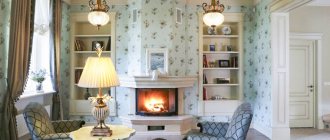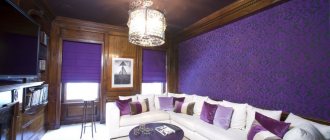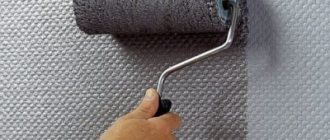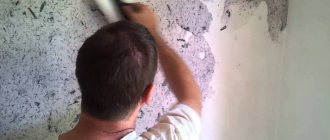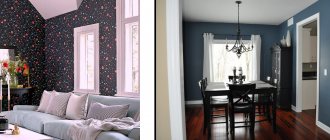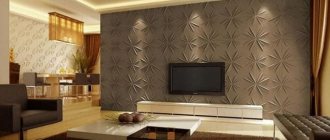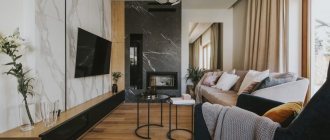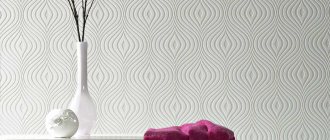Wall paint color palette
The chosen palette of wall paint colors is a very significant factor in the final appearance of the room. You must understand that all colors are divided into two large groups: warm and cold, but at the same time, they can be combined, although, at first glance, this may seem impossible.
So, for example, if you take contrasting colors for water-based paint, you can enhance one color with another, thereby enhancing the effect of its perception. In addition, by playing with colors, you can change the geometric visual perception of the room.
How do different colors of paint affect a person’s subconscious?
When choosing a palette of paint colors for walls, the effect of a particular color on a person’s psychological state must be taken into account. Below you can find general data on the effects of primary paint colors on our brain.
White color. This color makes the room spacious and comprehensive. But if you use exclusively white color or its superiority over other colors is repeated, then the room will become uncomfortable, and may also seem boring to many.
Red color. This color produces an exciting effect on the human body. If you plan to use red in the wall paint color palette, you must understand that you cannot overdo it, otherwise the room will quickly tire a person.
Yellow.
Wall paint color palette
This is a great color for temporary breakout rooms such as a dining room or loggia. It tones the body and provokes an influx of vitality.
Blue. This color has a calming effect on the human body and even helps normalize blood pressure. It is for these reasons that it is used along with the color green, which signals the brain to calm down, in a variety of medical settings. In everyday life, this color is ideal for the bathroom.
Orange color. If you use orange in the wall paint color palette, you must understand that despite the fact that it stimulates the human body to start the processes of restoring strength, you cannot overdo it with it, or it will begin to make you feel drowsy.
Purple. This color stimulates the body to concentrate mental activity, while it relaxes the nervous system and clears the mind for creativity.
Fiberglass wallpaper
Such wallpapers contain fiberglass in their structure, have a pronounced structure, and are perfect for painting.
They are very durable, lasting more than 20 years. This wallpaper can be used in rooms with high humidity - the bathroom or kitchen.
Interesting techniques with paint colors and secrets of use.
There are several factors that you should consider during the process when choosing a palette of wall paint colors:
- The same paint can look different on different surfaces. So, on a smooth surface the colors look lighter, on a rough surface - darker, on a matte surface - they become warmer, even if they are initially considered cold, on a polished surface - they give off freshness, even if it is a warm and hot red color;
- If you are looking for a bright interior, then the simplest and most effective option would be to paint adjacent walls in contrasting colors;
- Despite the fact that walls are usually used as a backdrop for interior items, you can do things a little differently. Namely, make interior items complement the main theme set by the painted walls. So, your interior will look more lively and juicy.
Coloring paint for walls palette. Classic palette of modern colors
“Alien” colors can add age, give the skin an unhealthy look, and unsightly shade the hair and eyes. While “your” palette will highlight the skin and highlight the natural blush and pigment of the lips. To learn how to choose colors for yourself, you need to understand how they differ.
All the shades that surround us are derived from three basic ones: red, blue and yellow. Mixing them gives us the colors of the second order - orange, green and purple. And with their help you can get any tone from the spectrum.
How to determine cool and warm colors?
The most primitive classifications suggest considering the entire yellow-orange-red part of the color wheel as warm shades, and blue-green-violet as cold shades. This is not entirely true, since such pure colors are usually found only in pictures. In practice, everything is different: clothing designers, for example, strive to use interesting, complex, mixed options. The difference between cool and warm shades of colors is what undertone each of them has: cool blue or warm orange.
It is important to understand and remember that any color can be warmer or colder - blue, purple or red, and select the shade individually in each case.
What are these warm colors?
- In yellow: mustard, sea buckthorn, curry, saffron, amber, sulfur yellow, sunflower, honey and egg yolk.
- In red: brick, coral, copper red, fiery red, tomato, poppy red, cinnabar, pomegranate and the like.
- In green: olive, khaki, pear, linden, myrtle, green pea, forest green and others.
- In blue: sky blue, petrol, moray, cornflower blue, turquoise, protective blue, sea green and so on.
What are these cool colors?
Color types of appearance and colors
To determine which, warm or cold, colors in clothes suit you, you need to understand which of the 4 color types you belong to:
Spring
. Warm color type. People of this type have light, transparent, bronze-golden or ivory skin. The eyes are usually blue, green or hazel. Hair can range from light to brown and can be straw, honey-copper or golden brown curls.
Autumn
. The second warm color type. The skin is transparent white to slightly golden. Eyes can be either light blue or the entire golden brown range (amber, brown, red, and so on). Autumn hair also includes warm shades: copper-gold, red and red-brown and the like.
Winter
. This cool color type is distinguished by flawless porcelain skin, which almost always has a bluish undertone. Eyes - all shades of ice blue, gray or brown (there are, however, also green). The hair is always contrasting, dark (from thick chestnut to blue-black).
Summer
. Representatives of this color type have milky, pale or olive skin, but always with a cool undertone. Eyes are “cool”: gray, gray-blue, light green. Hair can be light brown, also with an ashy tint. But even if “summer” has dark curls, there is still no “red” in them - just like “winters”, they will always have a silver-gray base.
How to glue wallpaper for painting and apply coloring compound
Each type of wallpaper has its own nuances of gluing and painting. Regardless of the material chosen, at the first stage of work you should ensure that you have the necessary tools and equipment, as well as select the optimal dye taking into account the developed design.
It is recommended to apply the coloring composition in two layers to ensure a high-quality result. When working with cheap coatings, this procedure may have to be performed three times. A roller with a fur coat made of sheepskin or velor with medium-length pile is ideal as a tool for applying dye. You will also need a brush to treat corners and hard-to-reach areas.
To ensure that the finish is even and the glue does not leave stains, it is better to glue the wallpaper together
Important! It is not recommended to use foam rollers to cover wallpaper for painting. Using this tool for painting can result in the appearance of small air bubbles and deformation of the top layer of wallpaper.
Types of wallpaper and recommended dyes:
| Finish type | Recommended dyes |
| Non-woven | Water-based (matte and glossy) |
| Paper | Water-based (matte and glossy) |
| Fiberglass | Polymer (acrylic and latex (water-dispersed)) |
Features of gluing vinyl wallpaper for painting
Non-woven or vinyl wallpapers are made from textile and cellulose particles. This type of finish has a small thickness, but this does not affect the strength characteristics. The material is not subject to burnout under the influence of high temperature and deformation changes. There is no need to carefully level the walls before gluing such wallpaper.
When gluing wallpaper with a repeating textured pattern, material consumption should be increased so that the joints are even.
To work you will need an adhesive composition. Before purchasing, be sure to read the manufacturer’s instructions or consult with the seller to select the material with suitable properties. To apply the glue you will need a roller.
Before gluing non-woven wallpaper, the surface of the walls should be cleaned and dried. The procedure does not involve the need to treat the canvas with an adhesive composition. It should only be applied to the surface of the walls. The wallpaper is fixed using freshly applied glue, so you need to prepare everything you need in advance and cut the roll into pieces of the appropriate size with an additional margin of 6-8 cm.
After gluing the wallpaper to the wall, you need to get rid of air bubbles with a special spatula
The procedure looks like this:
- An adhesive composition is applied to the wall.
- A strip of wallpaper is applied to the treated surface.
- The material is gently pressed. Wallpaper should be aligned in the direction from the central part to the edges.
- Using a plastic spatula, remove all the air from under the canvas.
In order to optimally use the dye, you need to use a medium-pile roller when painting wallpaper.
You need to act as quickly and carefully as possible. Do not allow glue to get on the front of the wallpaper, since it is extremely difficult to remove after the composition dries. If this happens, you need to wipe off the dirt immediately. Before you start staining, you need to wait at least a day.
When gluing wallpaper for painting on the ceiling, you should pay special attention to the joints
Finishing vinyl wallpaper for painting on the wall: how to paint the canvas
Water-based and acrylic dyes are suitable as a finishing coating for vinyl wallpaper. The use of oil-based formulations is not permitted. They contain solvent which may damage the material. To avoid negative consequences, it is recommended to cut off a small piece of wallpaper and test paint it. This will allow you to evaluate the consistency of the coloring composition and understand how to work with it.
Note! To fully evaluate the dyeing result, as well as the saturation and depth of the color, you must wait until the tested section is completely dry. When dry, the coating becomes lighter.
In order for the wallpaper to be painted evenly, it is necessary to work the wall in even parts
To paint, you need to dip the roller in the composition and wait until the tool is saturated with paint. The material is applied to wallpaper sheets for walls for painting using vertical movements. You need to act smoothly, without strong pressure. If, after drying, poorly painted areas remain on the surface, re-application is performed. It will hide all imperfections. The second layer is applied only after the surface is completely dry.
Gluing fiberglass wallpaper for painting: how to prepare walls for finishing
Fiberglass finishing is made on the basis of glass fibers and is most often presented on sale as photo wallpaper. To produce the coating, environmentally friendly materials are used: dolomite, lime, soda, quartz sand. After which the threads are integrated into the paper base. The process of gluing fiberglass wallpaper is quite simple, although it is not without some nuances. At the same time, it is very important to follow the technology, because it is very difficult to tear the canvas off the wall.
The procedure for gluing fiberglass wallpaper is carried out in several stages. First you need to get rid of the old coating. This type of work will require some effort and specific knowledge. The use of cheap, low quality glue is not allowed. Wallpaper has a fairly high price and requires high-quality fixation.
When using smooth wallpaper for painting, the wall should first be plastered and sanded
The gluing procedure is carried out in the manner described previously. The wallpaper remains dry, and the glue is applied only to the surface of the walls, as is the case with non-woven material. When working, it is necessary to exclude the possibility of ultraviolet radiation hitting the fiberglass. The material is very fragile, so clothing should be as closed as possible. Fiberglass particles coming into contact with the skin may cause irritation.
For gluing fiberglass wallpaper, you should use only high-quality adhesive.
Finishing of fiberglass wallpaper for painting
The painting procedure begins only after the material has completely dried. Fiberglass wallpaper requires at least two days. Treatment of the room should begin from the corner areas. To apply the paint composition, you can use a small roller or paint brush.
Experts do not recommend trying to cover the entire perimeter during the painting process. It is better to apply the composition in small pieces. For work, it is preferable to use an acrylic-based dye. Paintable wallpaper with a light glossy finish looks good in the interior. At the same time, it is very important not to overdo it with the thickness of the composition and the number of layers, otherwise the entire relief pattern will become clogged.
If you plan to paint fiberglass wallpaper in light shades, you should pay attention to ensure that the primer is as transparent as possible
Helpful advice! Before applying paint, the fiberglass fabric must be treated with a primer. Due to this, particles of the material are retained inside, and the coating becomes safe for human health.
Such wallpapers open up a wide range of possibilities for creativity. During the coloring process, you can use any available means and materials to achieve the desired effect, for example, stencils or rollers with a pattern. They can be made independently or purchased ready-made at any hardware store.
How to apply paper-based wallpaper for painting
Most often, paper-based wallpaper is decorated with a pattern; it can also be used to decorate the ceiling. This type of material belongs to budget product options, which is accompanied by certain disadvantages: during the process of gluing the canvases, folds or bubbles may form. But this in no way affects the strength, because many paper wallpapers have a two-layer structure.
When gluing paper wallpaper, the glue is applied both to the walls and to the surface of the canvas
Unlike vinyl and fiberglass materials, these wallpapers are also treated with glue, which is also applied to the walls. After this, the piece must be carefully applied to the surface and, moving slowly with the help of a roller, smooth it evenly. To prevent the appearance of bubbles and large accumulations of air under the canvas, you can use a spatula instead of a roller.
If you plan to use smooth wallpaper for painting, the surface of the walls should be carefully prepared. Otherwise, all defects will be clearly visible.
Before gluing thin paper wallpaper, you should remove all the old coating and carefully sand the surface of the walls or ceiling
Wall preparation involves the following procedures:
- removal of paint and old coating;
- applying plaster for leveling;
- primer treatment.
Helpful advice! If there are large cracks and holes on the surface, they should be repaired using putty.
A high-quality soil mixture determines the reliability of fastening wallpaper for painting to the wall, and also eliminates the appearance of mold and fungi under the canvas
Paper wallpaper sheets are glued end-to-end, without adjustment. It takes about a day to dry completely.
Finishing paper wallpaper for painting: how to paint two-layer canvases
For finishing paper webs, it is better to use a water-based composition or acrylic-based paint. As a tool for applying it, it is better to take a roller or a spray gun, although the ideal option is still a spray gun.
Typically, wallpaper for painting is white, neutral in color, but sometimes you can find materials of other colors
When the canvases are completely dry after gluing, the dye must be applied in two layers. Between them you should take breaks from working to allow the coating to dry. Experienced craftsmen perform three-layer painting. In this case, painters fix the top coating using a special varnish composition that ensures water resistance.
Three-layer painting should be used only if you have the appropriate skills and knowledge, since this method has disadvantages - if the work is done poorly, all errors will be clearly visible on the surface.
There are many ways to paint wallpaper for painting: starting with special techniques for applying the composition, for example, combined, monochromatic or coloring with a gradient effect, ending with a choice of colors and patterns that create a certain mood.
There are general rules that apply to all types of wallpaper. For hallways and large rooms it is better to use matte paints, while for small rooms a semi-matte finish is suitable. Using light colors you can visually expand the space, and using paint with a vertical stripe allows you to “raise” the walls. In this case, imagination is practically unlimited, especially when it comes to smooth wallpaper, which can even be decorated with painting.
Choosing paint for wallpaper
The palette of colors for wallpaper today is the most diverse. You can find the most interesting colors and shades. The palette of colors for painting wallpaper does not leave users disappointed. A wide range helps solve the problem of optimal choice. In addition, you can consult with the manager of a hardware store or refer to reviews about the products you need. In the photo you can see an assortment of various colors.
Color palette
Consumer reviews about the best options for choosing wallpaper paint for painting
The most popular and popular option is acrylic paint for wallpaper that can be painted. They give preference to it because it has excellent performance qualities. Acrylic paint for wallpaper is wear-resistant and durable. In addition, it can be washed.
Tools and accessories
It is more convenient to use a roller to paint wallpaper. The roller should have a long pile in order to paint the relief surface “to the bottom”. To paint the corners you will need thin brushes.
As with any painting, you will need a paint container and paper tape to protect cornices, baseboards, and heating pipes.
In general, it is better to spend time on careful preparatory work and look on the Internet for instructions on how to paint wallpaper.
Tips for those who do DIY repairs
If you have not done such types of work intended for painting, then first you should purchase a small amount of paint, for example, 1 liter, to try. At the same time, do not throw away the sticker with the name of the manufacturer and color. At home, you can only paint an area of no more than 1 m. After drying, you can examine the result of your work and decide how much you like it. If the resulting effect is what you need, then it’s time to return to the hardware store to buy more paint.
Paint consumption is difficult to predict. To paint the walls, you spend approximately 200 to 250 g per square meter. Instructions from the manufacturer will help you calculate paint consumption more accurately. Using the information provided in the instructions, you can determine the paint consumption for any room in your apartment or house. And for tinting, professional craftsmen advise choosing a color that is half a tone lighter than the one you chose from the catalog.
Painting technology
Most manufacturers produce wallpaper that can be painted in light colors to simplify the process of designing, choosing, and combining colors. Mixtures can only be applied to dry surfaces, regardless of the type of material and the expected result. Monotonous wallpaper is suitable for formal, serious rooms. You can simply apply a special strengthening composition that will not affect the color of the base, or completely change the shade and make a new design. Paint application can be carried out using various technologies.
Selecting a texture
This coloring technique allows you to create a three-dimensional pattern, lighten or darken it against the general background. In addition to aesthetic benefits, highlighting the texture will help adjust the parameters of the room. The pronounced structure of many finishing materials can mask the relief of surfaces and make successful accents in certain areas. There are several ways to designate beautiful patterns on wallpaper using paint:
- Painting the reverse side of non-woven wallpaper. After drying and gluing to the wall, the paint shows through on the front side, creating a beautiful background for an expressive drawing. The pattern can be left naturally light or brought several tones closer to the base with a special roller with a short thief.
- Painting the wall under the wallpaper in a bright color. The wallpaper base will soften the surface, thereby highlighting the convex pattern. It can also be painted or left white.
- Partial paint removal from freshly painted wallpaper. Use a damp cloth to make slightly noticeable stains on the surface, dimming the brightness of the design. After drying, it can be painted a different color.
Combination of 2 or more colors
A combination of several close or opposite shades in one room is used to highlight zones and to give relevance to a certain style. To create a harmonious contrast, you will need some knowledge of color. It is necessary to combine shades of ceiling and wall surfaces according to certain rules:
- Place related colors nearby (for example, lilac and gray, blue and mint);
- Use gradient coloring of wallpaper - create smooth transitions from a bright tone to a pale one and vice versa;
- You can emphasize the main color with a combination of contrasting shades;
- Use colors found in nature in large quantities, for example, on opposite walls and ceilings. Blue and beige, green and brown go well together.
The area and location of the painted wallpaper are of great importance. Depending on the goal and design idea, several models of combining shades are used. For zoning, a vertical combination of colors is used, often a gradient. Diagonal, horizontal division is used to visually expand and narrow space.
Do-it-yourself drawing on wallpaper
You can create a unique interior using drawings. Wallpaper can be painted using various techniques. Any base will do for this. Simple decoration is done with a brush or spray, complex compositions are created with a textured roller and other tools. You can decorate a paper surface with your own hands in the following ways:
- Using a roller with a convex pattern. The paint application tool consists of two parts - a rubber and a textured spool. When painting on your own, the wall is divided into strips and passed with a roller clearly along the line so that the rhythm of the drawing does not go astray and the pattern does not become smeared.
- Using a stencil. You can buy a template in a store or make it yourself from cardboard, plastic or film. The stencil is attached to the wall with masking tape and the paint is applied with a foam sponge.
- By stamping method. You can use special devices with a comfortable handle or improvised means (cork stopper, broom, your own palm). The entire surface of the stamp is evenly coated with paint and pressed against the wallpaper. Using a sponge using the padding method, you can create an abstract design.
- Application of simple patterns, painting. Even a master unrelated to art can draw rings, squares, and triangles of various sizes on wallpaper. It may be difficult to get a complete picture. To simplify the task, use a projector. The sheet with the drawing is brought to the magnifier and directed at the wall. The picture is outlined with a pencil, the edges are covered with masking tape and painted.
Acrylic paint
Acrylic paint will be a good option if the wallpaper:
It is also suitable for glass wallpaper.
The principle of painting is very simple: paint is applied in an even layer to a previously prepared surface (leveled and dry) using a sprayer or roller, as shown in the photo. In addition to wallpaper, other substrates can be painted with this paint: cement or cement-lime plaster, wood, concrete, brick.
This paint has its own advantages and distinctive features. It is easy to clean and emphasizes the structure of the surface for painting. The palette of shades will amaze you with its diversity. When applied to walls it does not flow. To allow the paint to dry completely, just wait 1 day. It is noteworthy that this base is ideal even for rooms with high humidity.
Advantages of painting non-woven wallpaper
Non-woven wallpaper, just like paper wallpaper, is based on a cellulose component.
During production, special synthetic additives are added to the pulp mass, giving the wallpaper thickness, strength, and elasticity.
This type of wallpaper has a pronounced structural surface, so they are especially good for painting: it is enough to purchase non-woven wallpaper to be painted in a light neutral tone, and you can consider that a fourth of the work has already been done.
Water-based paint
Painting wallpaper with water-based paint will help maintain an optimal microclimate in the room. An excellent option for painting surfaces made of concrete, plaster, brick, as well as those covered with wallpaper.
Despite the fact that it is produced white, coloring pigments give its color the necessary shade. That's why she has a rich palette. The paint is safe and environmentally friendly. It dries very quickly - it takes about 2-3 days to dry completely. This mixture is excellent for painting products:
- paper;
- fiberglass;
- fiberglass.
Tikkurila performance characteristics
Tikkurila wallpaper paint is noticeably different from other latex water-based paint products with its soft silky sheen. Its undeniable advantage is considered to be the spectacular highlighting of the relief of structural products. It is ideal for both walls and ceilings. In the photo you can see the color palette of this type of latex paint.
This option is simply ideal for painting wallpaper. The products do not get wet and do not subsequently lag behind the surface of the walls. Thus, in itself there is no need to glue the wallpaper. This paint is best suited to non-woven products. A special roller is used to apply it to the surface of the walls.
Modern materials allow the apartment owners themselves to create a unique design.
Preliminary work
As you know, well-done preparatory work is the key to a good result.
If you decide to paint the walls in a room, and wallpaper is used as a base, then you need to pay special attention to gluing the wallpaper.
Non-woven and vinyl wallpaper will hide minor unevenness and cracks in surfaces.
Note!
Wallpaper for the bedroom - 125 photos and videos of stylish and beautiful ideas for decorating a bedroom using wallpaperPaper wallpaper: TOP-130 photos and video reviews. Advantages and disadvantages of paper wallpaper. DIY gluing instructions. Colors and shades
3D wallpaper - 130 photos and videos describing how to use 3D wallpaper with your own hands
For gluing, you must use only special glue. Freshly applied wallpaper must be given enough time to dry.
The paint makes the wallpaper heavier; if it is not dry, it will simply fall off.
In general, gluing wallpaper for painting is even easier than gluing ordinary paper wallpaper - it does not tear, does not shrink, is dense and elastic.
Tikkurila color catalogs
Using paintable wallpaper is an excellent opportunity for those who love change to make changes to their surroundings. The main thing is that the paint is chosen correctly.
Different surfaces require the use of different paints. This is required since the products differ from each other in chemical composition. For such a purpose, paint containing chemically active solvent components is considered categorically unsuitable: they will simply dissolve the surface layer from the outside. To choose a color, you can experiment with adding a coloring pigment and test it on a piece of wallpaper.
Repainting
A huge advantage of painting wallpaper is that it can be repainted several times. When painting for the first time, the paint layer must be allowed to dry thoroughly.
With each subsequent dyeing, the color will become more saturated. When re-painting after a long time, the surface must be thoroughly dust-free.
Sandy hair color
Not so long ago, women, imitating the incomparable Marilyn, mercilessly etch their hair, causing it to become snow-white. Fashion of the 21st century is not so merciless to our appearance. Now everything natural is considered relevant. Although, of course, in order for a brunette to turn into the owner of light curls (for example, wearing sandy hair), you will also have to try a little.
What does sand hair color look like?
It brings together ashy notes (from the cold range), as well as warm base tones. Therefore, it is suitable for owners of beauty of any color type. All paints from this “family” do not contain red pigment, so even those with light eyes and skin can safely apply them.
If you take a handful of sand in your hands, it turns out that your palms are filled with a lot of undertones: here you have brown (especially if the sand is wet), and beige, and snow-white. Correctly colored hair looks the same. By the way, the sand line has many shades: light brown, golden, blond...
It is not necessary to dye every hair. Based on this paint, you can do degradation (light ends, dark roots, and throughout the “mane” there is a smooth transition from one color to another), bronzing or coloring. Masters do not make sharp contrasts - they mix two or three shades that resemble each other. Then the image turns out not fake, natural, and the hair color is rich and bright.
Sand hair color: choosing a shade
Dark colors
A good solution for those with green (marsh), brown or black eyes. If your eyes are, say, blue, the proximity of colored strands can make them less noticeable. Important: the more freckles, capillary networks or just pimples on your cheeks, the darker the paint you should choose!
Sandy blonde
On the contrary, this is a solution for a girl with fair skin and blue eyes. The hair will turn out very beautiful, and its owner will always be looked at on the street. At its core, it is a light golden blonde. It can be an excellent basis for bronding and other fashionable coloring, in which several shades are mixed at once in one hairstyle.
Sandy blonde
One hundred percent natural, it works equally well on both light (even golden) and brown hair. It is considered cold, so it is recommended for girls with typical winter or summer beauty, that is, with gray, blue eyes and fair skin.
By the way, you can create such a shade on your hair not only with the help of permanent dye, but also with the help of tint products (of course, if the base is light brown strands). At its core, this color is a duet of light brown and golden. Nowadays, the most relevant coloring is considered to be maximum highlighting of the ends, painting over the entire head; the roots of the hair remain intact, that is, dark (brown).
Sand golden
Another color for a stunning exit. Rich, radiant, it looks like a million. It looks especially advantageous in the summer, under the generous rays of the sun. The secret of the color is simple: its “recipe” contains a lot of red notes. It will best suit a tanned girl with dark (preferably brown) eyes.
The colors of the sand line are one of the main “must haves” of this season. Maybe you'd like to try one of these too?
Similar hair shades that will suit you:
Go to section: Hair coloring: types, methods, palette of fashionable shades
Paint in two colors
Not many people decide to paint their bedroom or living room in combination. Some are accustomed to universal colors, others are afraid of ruining the interior with their own hands. Moreover, no one will return money for mistakes made.
But at the same time, many design solutions involve a combination of different colors in the room. This can be achieved either by pasting different wallpapers, or by painting them in different color shades.
Remember that today special combination methods have been developed.
You can combine:
- colors similar in color;
- making gradient transitions;
- experimenting with different palettes.
Special design solutions have been invented to hide transitions. One of them is molding. Moldings are made from safe polymers and are easily attached not only to the ceiling, but also to the walls. It is more advisable to use wooden or plaster molding in rooms where wooden furniture predominates - these could be bedrooms or offices. Polyurethane moldings are moisture resistant and should be installed in kitchens or bathrooms. All moldings are attached to the walls using special glue.
Borders, planks and slats are popular in the design environment - they can be made from both natural and artificial materials. The choice is determined only by the design of the premises and the financial situation of the customer.
But most often for ordinary apartments, masking tape is used. It is easily glued and easily dismantled after painting. Masking tape costs little money, is very durable, and can be used in a wide range of temperatures from scorching heat to bitter cold.
Let us dwell in more detail on the combined methods of painting wallpaper:
- The most provocative method is the one called “accent wall” . With this method, not half the wall is painted one color, but the other half is painted another. Here we are talking about painting three walls one color, and the fourth another. Or this method is used for ornamentally highlighting protrusions - fireplaces, chimneys and stoves.
- Horizontal division is most often found in city apartments, especially in cases where the lower part of the wall is stucco. The division can be either central or with a significant advantage. The transition is usually decorated with molding.
If the molding is not included in the design, then the transition should be made using masking tape, but it should be removed within an hour after painting.
- In children's rooms or in rooms intended for children, inserts of geometric shapes are often made. First, the entire wall is painted with the selected color and the shapes are marked using masking tape. The second layer, which will differ in color, is applied after the first has completely dried.
- , the gradient method of painting was popular . Today, the fashion for gradient has returned. You can paint each wall a different color or transition from dark to light. In the second case, the wall is first painted one color, and then part of it is shaded.
- Stripes, diamonds and polka dots are the least used and can be applied using masking tape or a stencil.
How to choose paint color for walls?
Lightening light brown, dark and red hair. Removing yellowness from bleached hair Natural hair lighteners. How to lighten your hair without dye. Safe hair coloring. Modern technologies Natural ammonia-free paints. Gentle hair coloring
The fastest, most practical and easiest method of façade coating is water-based emulsion. It is easy to paint and dries quickly. Both manual application (roller, brush) and spraying are possible. The paint can be applied (and is usually applied) in several passes, it does not peel off. It is non-toxic, you can work without a respirator.
There are also disadvantages. One of them is aesthetic: the water-based emulsion is available only in white. To eliminate this drawback, a color for water-based paint is used. With its help you can give the surface any light shade: pink, beige, cream.
Types and features of application
Colors are produced in different consistencies: paste, powder, liquid dye. This is a color-saturated substance; it is added to paint in small quantities (maximum 20%). No longer recommended because... the performance characteristics of the paint itself will suffer.
In terms of composition, colors for water-based paint can be inorganic and natural.
The latter are brighter, but less resistant to fading. When choosing a color, you can be guided by special color tables; they are often available in stores.
Pigments, as a rule, are universal: suitable not only for water-based paints, but also for latex paints, adhesives, and for coloring plasters. Used for facade and interior work. For more detailed recommendations for use, please refer to the manufacturer's instructions.
It is necessary to mix the paint and color immediately before painting, because... otherwise it will settle to the bottom. First, the required amount is added to a small portion of paint and mixed thoroughly. Then slowly pour the prepared mixture into the work bucket, also with constant stirring.
Attention: it is recommended to knead the entire required volume at once, because... It is impossible to achieve exactly the same shade later. Once the paint dries, the difference will become noticeable. If the shades of two adjacent walls are slightly different, this is not fatal. It is much worse when multi-colored stripes end up next to each other on the same plane.
It should be taken into account that a freshly painted surface and a completely dry surface differ in shade. Immediately after painting it is too early to conclude that the color did not match.
Tinting Tikkuril paint
Construction stores often have special machines for mixing paint and color.
Painting features
Paintable wallpaper is a special model characterized by the absence of a pattern and the presence of relief. The popular material is more expensive than conventional analogues, but has a long service life. This is an ideal option for those who like to change their decor; just repaint the surface in a different tone. Manufacturers produce products mainly in white, and only in rare cases are there colored specimens.
When painting wallpaper, you should follow the rules that allow you to achieve the best results. Paint can only be applied to a dry canvas, so after pasting it is necessary to wait a certain period, usually 2 days is enough. Before starting work, it is necessary to protect the floor, ceiling, and windows from accidental ingress of paint. Polyethylene is suitable for these purposes; the joints are covered with masking tape.
The paint is selected depending on the type of wallpaper chosen. For non-woven models, it is recommended to use latex-based products; for vinyl, water-based emulsion is suitable; glass wallpaper can be painted with acrylic and latex coloring compounds. Before application, please read the instructions included with your purchase. Some species must be diluted, while other formulations are used without preparation.
The paint is usually applied in two layers. The first is a primer, the second is a finishing one. There should be an interval of 12 hours between them. During this time, the first layer will dry completely. To ensure that transitions are not visible after painting, the surface must be painted in one pass. For hard-to-reach places, small rollers and brushes are used.
After the base coating has dried, the surface can be decorated with various ornaments and images, then coated with colorless varnish. The process of applying this layer is similar to the previous one, also occurring in two stages. For work, you can use glossy or matte options. This coating is easy to clean from dirt.
How to choose the right paint for walls?
Mixing yourself can be done manually, with an electric drill or using a mixer. Tikkuril paint tinting is performed by professionals for a small surcharge.
Video “Tint colors for water-based paint and tinting”:
Unused water-based paint colors can be stored for up to three years. To preserve it, you need to fill it with water. Do not stir.
Price
The price for color for water-based paint is:
— domestic Tex — from 42 to 200 rubles;
— Dufa — 270 — 370r;
— Tikkurila — from 1000 rubles per liter.
The price for tinting Tikkuril paint is on average 10-15 rubles per kg.

